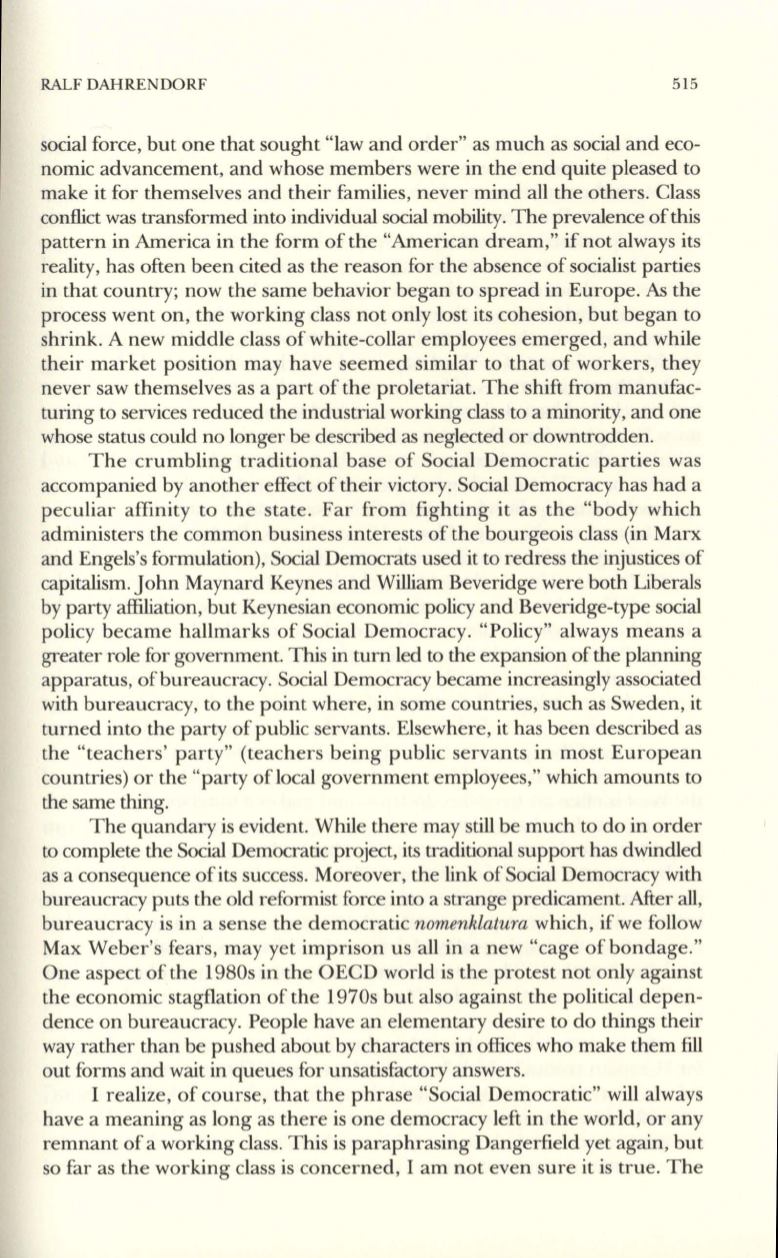
RALF DAHRENDORF
515
social force, but one that sought "law and order" as much as social and eco–
nomic advancement, and whose members were in the end quite pleased to
make it for themselves and their families, never mind all the others. Class
conflict was transformed into individual social mobility. The prevalence of this
pattern in America in the form of the "American dream," if not always its
reality, has often been cited as the reason for the absence of socialist parties
in that country; now the same behavior began to spread in Europe.
As
the
process went on, the working class not only lost its cohesion, but began to
shrink. A new middle class of white-collar employees emerged, and while
their market position may have seemed similar to that of workers, they
never saw themselves as a part of the proletariat. The shift from manufac–
turing to services reduced the industrial working class to a minority, and one
whose status could no longer be described as neglected or downtrodden.
The crumbling traditional base of Social Democratic parties was
accompanied by another effect of their victory. Social Democracy has had a
peculiar affinity to the state. Far from fighting it as the "body which
administers the common business interests of the bourgeois class (in Marx
and Engels's formulation), Social Democrats used it to redress the injustices of
capitalism. John Maynard Keynes and William Beveridge were both Liberals
by party affiliation, but Keynesian economic policy and Beveridge-type social
policy became hallmarks of Social Democracy. "Policy" always means a
greater role for government. This in turn led to the expansion of the planning
apparatus, of bureaucracy. Social Democracy became increasingly associated
with bureaucracy, to the point where, in some countries, such as Sweden, it
turned into the party of public servants. Elsewhere, it has been described as
the "teachers' party" (teachers being public servants in most European
countries) or the "party oflocal government employees," which amounts to
the same thing.
The quandary is evident. While there may still be much to do in order
to complete the Social Democratic project, its traditional support has dwindled
as a consequence of its success. Moreover, the link of Social Democracy with
bureaucracy puts the old reformist force into a strange predicament. After
all,
bureaucracy is in a sense the democratic
nomenklatura
which, if we follow
Max Weber's fears, may yet imprison us all in a new "cage of bondage."
One aspect of the 1980s in the OECD world is the protest not only against
the economic stagflation of the 1970s but also against the political depen–
dence on bureaucracy. People have an elementary desire to do things their
way rather than be pushed about by characters in offices who make them
fill
out forms and wait in queues for unsatisfactory answers.
I realize, of course, that the phrase "Social Democratic" will always
have a meaning as long as there is one democracy left in the world, or any
remnant of a working class. This is paraphrasing Dangerfield yet again, but
so far as the working class is concerned, I am not even sure it is true. The


